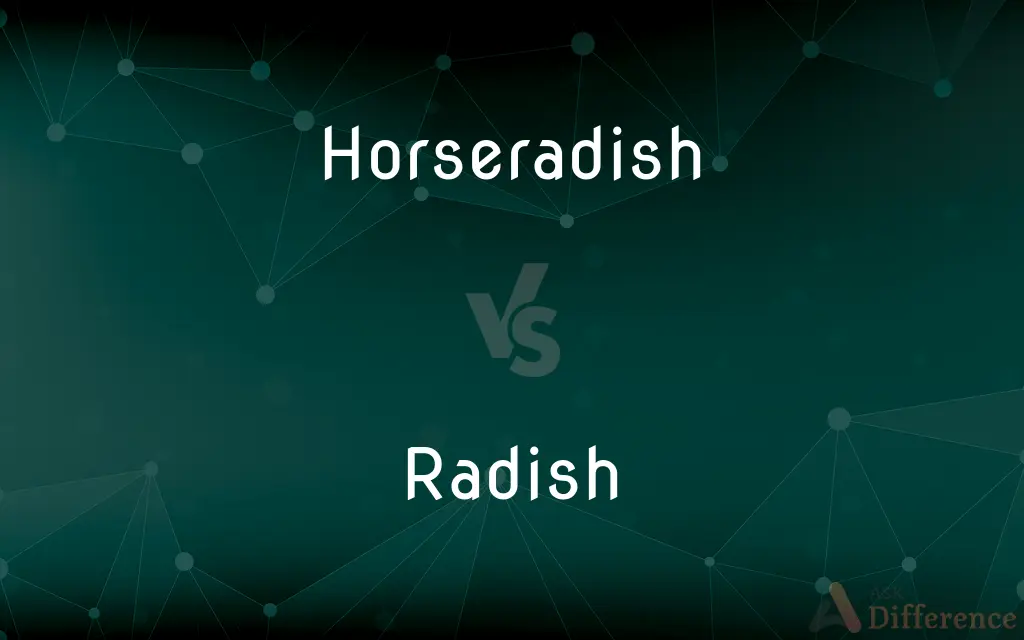Horseradish vs. Radish — What's the Difference?
Edited by Tayyaba Rehman — By Fiza Rafique — Updated on November 6, 2023
Horseradish is a pungent root used as a spice, while a radish is a crunchy, mild to peppery vegetable eaten raw or cooked.

Difference Between Horseradish and Radish
Table of Contents
ADVERTISEMENT
Key Differences
Horseradish, derived from a large white root, is known for its strong, pungent flavor used primarily as a condiment. Radishes, on the other hand, are small, colorful root vegetables, typically eaten whole and known for their crisp texture and a peppery to sweet taste.
The horseradish plant belongs to the Brassicaceae family, akin to mustard and wasabi, and its paste is often used in sauces and as a meat accompaniment. Radishes are also part of the Brassicaceae family but are more commonly included in salads, offering a crunchy, sharp bite that complements greens and other vegetables.
Horseradish roots are larger and not commonly consumed whole or raw due to their intense flavor, unlike radishes, which are often served raw in salads or as garnishes. While radishes can be red, purple, or white, horseradish is typically found in its processed form as a creamy white sauce or paste.
In cuisine, horseradish is typically grated and used in prepared sauces, including cocktail sauce, while radishes are sliced, diced, or eaten whole and used to add flavor and crunch to dishes. Horseradish provides a hot, mustard-like flavor, whereas radishes have a range from mild to fiery, depending on the variety.
One distinct use of horseradish is as an accompaniment to prime rib or in bloody Marys, offering a heat that can clear sinuses. Radishes can be pickled, roasted, or eaten raw, and are often a colorful, zesty addition to tacos, salads, and as an edible garnish.
ADVERTISEMENT
Comparison Chart
Part Used
Typically, the root is used
Roots are commonly eaten
Flavor
Pungent, spicy
Mild to peppery
Usage
As a condiment or spice
Eaten raw or cooked as a vegetable
Size and Shape
Larger and longer roots
Small, round or elongated bulbs
Color
Roots are white
Comes in red, purple, white, and pink
Compare with Definitions
Horseradish
Horseradish is grated and mixed into sauces or used to enhance meats.
He garnished the steak with a generous dollop of horseradish.
Radish
Radish is a small, colorful vegetable often used in salads and garnishes.
The radish roses garnished the platter beautifully.
Horseradish
Horseradish is the root of a plant in the mustard family, known for its strong flavor.
The horseradish gave the homemade mustard its distinctive heat.
Radish
Radishes are part of the Brassicaceae family, grown for their roots.
He planted radishes in his garden for a quick harvest.
Horseradish
Horseradish is a pungent root used as a spice or condiment.
She added a spoonful of horseradish to the sauce for extra kick.
Radish
Radish can be eaten raw, cooked, or pickled, depending on the variety.
The pickled radishes added a tangy flavor to the tacos.
Horseradish
Horseradish root is processed into a paste or sauce for culinary uses.
I bought a jar of horseradish to make cocktail sauce.
Radish
Radish varieties can range from mild to very spicy.
The Daikon radish is milder compared to the smaller red radish.
Horseradish
Horseradish is often used in small amounts due to its intense heat.
A little horseradish goes a long way in spicing up a dish.
Radish
The radish (Raphanus raphanistrum subsp. sativus) is an edible root vegetable of the family Brassicaceae that was domesticated in Asia prior to Roman times.
Horseradish
Horseradish (Armoracia rusticana, syn. Cochlearia armoracia) is a perennial plant of the family Brassicaceae (which also includes mustard, wasabi, broccoli, cabbage, and radish).
Radish
A swollen pungent-tasting edible root, especially a variety which is small, spherical, and red, and eaten raw with salad.
Horseradish
A coarse Eurasian plant (Armoracia rusticana) in the mustard family, having a thick, whitish, pungent root, large basal leaves, and white flowers in a terminal panicle.
Radish
The plant of the cabbage family which yields the radish.
Horseradish
The roots of this plant.
Radish
A Eurasian plant (Raphanus sativus) in the mustard family, having a fleshy edible root and white to purple flowers clustered in a terminal raceme.
Horseradish
A sharp condiment made from the grated roots of this plant.
Radish
The pungent root of this plant, often eaten raw.
Horseradish
Any of various pungent condiments resembling horseradish, such as wasabi.
Radish
A plant of the Brassicaceae family, Raphanus sativus or Raphanus raphanistrum subsp. sativus, having an edible root.
Horseradish
(countable) A plant of the mustard family, Armoracia rusticana.
Radish
The root of this plant used as food. Some varieties are pungent and usually eaten raw in salads, etc., while others have a milder taste and are cooked.
Horseradish
(uncountable) A pungent condiment made from the root of the plant.
Radish
With a distinguishing word: some other plant of the Raphanus genus or Brassicaceae family.
Horseradish
The root of the horseradish plant; it is grated or ground and used for seasoning
Radish
The pungent fleshy root of a well-known cruciferous plant (Raphanus sativus); also, the whole plant.
Horseradish
Coarse Eurasian plant cultivated for its thick white pungent root
Radish
Pungent fleshy edible root
Horseradish
Grated horseradish root
Radish
Pungent edible root of any of various cultivated radish plants
Radish
Eurasian plant widely cultivated for its edible pungent root usually eaten raw
Radish
Radish is a crunchy, edible root vegetable with a peppery taste.
She sliced radishes to add a crisp bite to the salad.
Common Curiosities
What is a radish?
A radish is a crisp, edible root vegetable often eaten raw in salads.
What dishes use horseradish?
It is commonly used in sauces for steak, seafood, and in bloody Marys.
Are radishes spicy?
Radishes have a peppery taste, but some varieties can be quite mild.
What is horseradish?
Horseradish is a root vegetable known for its pungent taste used as a condiment.
Can you eat horseradish raw?
Yes, but it is usually grated and used sparingly due to its strong flavor.
Can you cook horseradish?
Cooking can diminish its pungent flavor, so it’s usually added raw.
What are common types of radishes?
Common varieties include red, Daikon, French Breakfast, and watermelon radishes.
How do you prepare radishes?
Radishes can be eaten raw, roasted, pickled, or added to dishes for crunch.
Is horseradish the same as wasabi?
No, they are different plants, but horseradish is often used as a wasabi substitute.
Are radishes healthy?
Yes, radishes are low in calories and contain vitamins and minerals.
How do you store horseradish?
Store it in the refrigerator, either whole or as a prepared sauce.
Can you grow horseradish at home?
Yes, it can be grown in gardens, but it can be invasive if not contained.
How long do radishes last?
Fresh radishes last about a week in the refrigerator.
Do radishes need to be peeled?
No, radishes are usually eaten with their skin for added texture and nutrients.
Is horseradish vegan?
Yes, horseradish itself is vegan, though prepared sauces may have added ingredients.
Share Your Discovery

Previous Comparison
Tap vs. Jazz
Next Comparison
Recreation vs. RecreateAuthor Spotlight
Written by
Fiza RafiqueFiza Rafique is a skilled content writer at AskDifference.com, where she meticulously refines and enhances written pieces. Drawing from her vast editorial expertise, Fiza ensures clarity, accuracy, and precision in every article. Passionate about language, she continually seeks to elevate the quality of content for readers worldwide.
Edited by
Tayyaba RehmanTayyaba Rehman is a distinguished writer, currently serving as a primary contributor to askdifference.com. As a researcher in semantics and etymology, Tayyaba's passion for the complexity of languages and their distinctions has found a perfect home on the platform. Tayyaba delves into the intricacies of language, distinguishing between commonly confused words and phrases, thereby providing clarity for readers worldwide.
















































